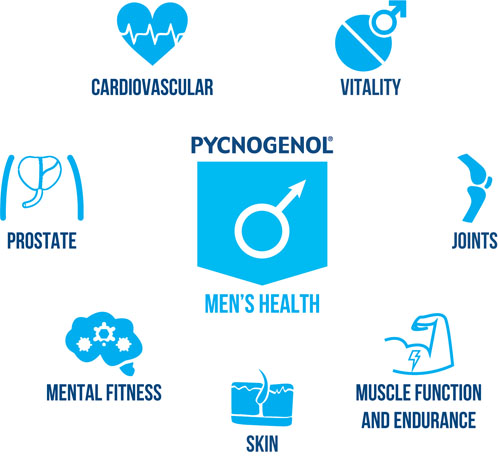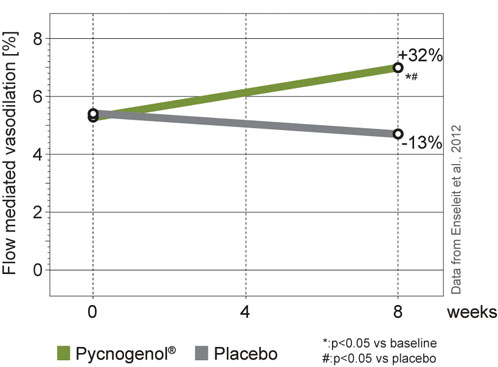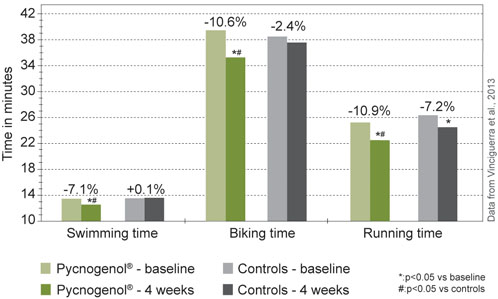Proposed factors contributing to the risk disparity, besides genetic risk factors, include unhealthier dietary and smoking habits, higher alcohol consumption and an underutilisation of healthcare compared with women.1
Movember is an annual global event during which men grow moustaches during the month of November to raise awareness and funds for men's health issues, such as prostate health, mental health, cancer and others.
Movember aims to address the stigma surrounding men’s health, promote early detection and intervention, and support research and programs to improve the well-being of men around the world.2
A broad catalogue of research supports Pycnogenol’s benefits for various areas of health that men are concerned about, such as prostate health, cardiovascular health, vitality, muscular function and endurance, joint health, hair and skincare and cognitive function.3–51
Pycnogenol French maritime pine bark is a natural multitasking ingredient comprising a unique blend of active compounds that, by exerting different mechanisms throughout the body, are effective for several different health aspects (Figure 1).
Prostate health
Benign prostatic hyperplasia/hypertrophy (BPH) is the non-malignant enlargement of the prostate and is a very common urological condition among older men, leading to increased urinary frequency and urgency.52

Figure 1: Pycnogenol for men's health
Although only 8% of the men in their forties are diagnosed with BPH, this figure rises to 50% of men in their sixties and 80% of men in their nineties.52
A clinical study with 75 men between 60 and 70 with signs and symptoms of BPH showed that Pycnogenol is beneficial for prostate health.3
After 2 months of taking Pycnogenol, the participating men reported of reduced frequency and urgency of urination and nocturia.
Pycnogenol intake also improved bladder voiding as the residual urine volume in the bladder was significantly reduced (by 51%) compared with a reduction of 35% in the control group. Straining and weak flow during urination were both improved in the Pycnogenol group compared with control patients.
The authors concluded that Pycnogenol is a possible option for the self-management of BPH in older men.
Cardiovascular health
Cardiovascular diseases are the leading cause of death in the world; accounting for approximately 30% of annual deaths, they include both heart and blood vessel disorders.53
In general, men have a higher risk of heart attack or stroke compared with women, constituting the majority of cardiovascular-related deaths at approximately 85%.54
Endothelial dysfunction is both the result and a risk factor of cardiovascular disease.55 The endothelium is the inner lining of all blood vessels and is significantly involved in many physiological functions, such as controlling blood pressure, blood clotting and signalling during inflammation.
Endothelial function and blood flow regulation are crucial for overall health.
Many different studies have shown that Pycnogenol has a positive effect on blood circulation and microcirculation by improving endothelial function and by lowering platelet aggregation without increasing bleeding time.4–21
Interestingly, it was found that a metabolite of Pycnogenol can be selectively taken up in endothelial cells and can thus exert its anti-inflammatory effects directly in the endothelium.6
In patients with coronary artery disease, the effects of Pycnogenol on endothelial function was investigated by assessing “flow-mediated dilation” in the upper arm artery.7

Figure 2: Pycnogenol ameliorates endothelial function
This 8-week randomised, double-blind placebo-controlled study showed an improvement in flow-mediated dilation by 32% in the Pycnogenol group, whereas it deteriorated slightly in placebo patients (Figure 2).
In addition, Pycnogenol has been shown to be beneficial for the “main” cardiovascular risk factors. Several clinical studies showed Pycnogenol’s potential to normalise blood pressure and to improve the blood lipid profile, as well as blood sugar values.8,9,22–30
Vitality
Physical and sexual vitality are the characteristics of an active and healthy life. Keeping the cardiovascular system healthy is key to maintaining good vitality and physical strength.
Insufficient blood supply to the erectile tissue of the penis is closely associated with cardiovascular problems.56 Erectile dysfunction can even be one of the first signs of cardiovascular diseases.56
Amelioration of the endothelial function by Pycnogenol doesn’t just benefit the heart; it also plays a role in the patented formulation, Prelox, combined with L-arginine, on erectile function.
Here, the dilation of the blood vessels leads to a better perfusion of the penis arteries that fill the erectile tissue with blood. This beneficial effect of Pycnogenol and the L-arginine in Prelox was shown in several clinical studies investigating sexual function in men.27,31,32,57–61
In addition, a positive effect on sperm quality was shown after Pycnogenol intake.33,34
Endurance, muscle function and post-exercise recovery
Engaging in physical activities also requires vitality and keeps the body fit and healthy. Sufficient muscle oxygenation is facilitated by relaxed blood vessels and improved blood flow, which warrants aerobic energy generation.
This increase in oxygen supply translates to acute oxidative stress derived from the higher production of free radicals in blood and muscles.62 Pycnogenol has been shown to improve muscular function, endurance and to support muscle recovery and reduce cramps by acting as a strong antioxidant.37–40
In a double-blind placebo-controlled study, 20–35-year-old participants took Pycnogenol for 60 days and then ran on a treadmill.
The endurance time of these recreational athletes was significantly increased by 21% after Pycnogenol supplementation compared with the baseline and by 13% compared with a placebo.37

Figure 3: Pycnogenol improves triathlon performance after 4 weeks
In another study, Pycnogenol intake for 4 weeks improved the performance of 32 male triathletes by reducing their overall triathlon times by 10 minutes and 48 seconds, compared with a training only time-reduction of 4 minutes and 36 seconds (Figure 3).38
The post-exercise levels of free radicals in the blood were significantly reduced by 26.7% in the Pycnogenol group. Additionally, the athletes reported 39.5% less post-training pain and 56.7% fewer cramps after supplementation with Pycnogenol.
The effects of 4 weeks of Pycnogenol supplementation on cramps and muscular pain after training was examined in another study.40 The number of cramps in untrained subjects was significantly reduced from an average of 4.8 events per week to 1.3 after Pycnogenol intake.
In athletes, cramp events occurred on average 8.6 times per week before the study and 2.4 times after Pycnogenol intake. Additionally, the pain score of the cramps was reduced by 76% and 87%, respectively, in untrained subjects and athletes taking Pycnogenol.
Joint health
Joint discomfort during or after sports can be very disturbing. Pycnogenol can relieve joint pain by exerting its anti-inflammatory properties directly in the liquid surrounding the joints and the knee cartilage.41–45
Pycnogenol has been shown to increase the synthesis of collagen and hyaluronic acid, which are important components of articular cartilage, the shock absorber of the joint.47
In addition, Pycnogenol led to a potent decrease of proinflammatory markers such as NF-κB and COX-enzymes, as well as a decline in cartilage-destroying enzymes.41–45
Pycnogenol has also been shown to act beneficially in patients presenting with joint problems.63–66 In a double-blind placebo-controlled study, 100 patients with mild to moderate osteoarthritis in the knee were supplemented with Pycnogenol for 3 months.65
Decreased discomfort (by 21.4%), reduction of stiffness in the knee (by 20%) and an improved ability to perform daily activities (by 19.6%) were observed in the Pycnogenol group (compared with placebo-controlled subjects).
Skin health
Skincare is not solely a women’s topic any more. Men are increasingly pursuing healthier and younger-looking skin. Healthy skin is well hydrated and shows a high level of elasticity, making it better able to deal with external stressors such as cold temperatures, smog or sun irradiation.
Pycnogenol was shown to increase skin elasticity by 25% by stimulating collagen synthesis and arresting the activity of collagen- and elastin-degrading enzymes.41,42,47
Additionally, clinical investigations of Pycnogenol supplementation for 12 weeks revealed the increased expression of hyaluronic acid synthase mRNA within the skin by 44%, leading to improved skin hydration by 21%.47
In a placebo-controlled double-blind study with 78 outdoor workers in an urban area, the water loss of the skin during the hot summer season could be reduced by 14% with Pycnogenol supplementation for 3 months (and only by 5% with a placebo).48
Skin elasticity was improved by 13% after supplementation, compared with an increase of 1% in the placebo group. Pycnogenol thus contributes to maintaining an elastic, smooth and youthful looking skin.
Mental fitness
Healthy cognitive function is vital for people at any age. Pycnogenol has shown remarkable benefits for cognition in children, students, healthy adults and in ageing people.49–51
A study, with subjects between 35 and 55 evaluated the effects of Pycnogenol on cognitive function in healthy professionals.49 In cognitive battery tests, improvement of attention (+13.4%), mental performance (+8.9%) and memory (+3.6%) were determined after Pycnogenol supplementation.
Overall cognitive function was improved by 10% in the Pycnogenol subjects compared with a slight increase of 4.3% in the control group.
References
- www.who.int/europe/news-room/fact-sheets/item/men-s-health.
- https://eu.movember.com/.
- A. Ledda, et al., Minerva Medica 109, 280–284 (2018).
- D.F. Fitzpatrick, et al., J Cardiovasc. Pharmacol. 32(4), 509–515 (1998).
- K. Nishioka, et al., Hypertens. Res. 30(9), 775–780 (2007).
- K. Uhlenhut, et al., Free Radic. Biol. Med. 53(2), 305–313 (2012).
- F. Enseleit, et al., Eur. Heart J. 33(13), 1589–1597 (2012).
- X. Liu, et al., Life Sci. 74(7), 855–862 (2004).
- S. Zibadi, et al., Nutr. Res. 28(5), 315–320 (2008).
- S. Hu, et al., Int. Angiol. 34(1), 43–52 (2015).
- G. Belcaro, et al., Clin. Appl. Thromb. Hemost. 2006;12(3):318-23.
- G. Belcaro, et al., Angiology 56(6), 699–705 (2005).
- M.R. Cesarone, et al., Angiology 57(4), 431–436 (2006).
- R. Steigerwalt, et al., J. Ocul. Pharmacol. Ther. 25(6), 537–540 (2009).
- S. Wang, et al., European Bulletin of Drug Research 7(2), 19–25 (1999).
- C. Cai, et al., Health Science Reports 6(1), e1045 (2023).
- M.R. Cesarone, et al., Minerva Cardioangiol. 67(4), 280–287 (2019).
- R. Luzzi, et al., Minerva Med. 105, 245–254 (2014).
- M.G. Grossi, et al., Panminerva Med. 52(2), 63–67 (2010).
- M. Araghi-Niknam, et al., Integrative Medicine 2(2/3), 73–77 (1999).
- M. Pütter, et al., Thrombosis Research 55, 155–161 (1999).
- S. Hosseini, et al., Nutr. Res. 21(9), 1251–1260 (2001).
- S. Stuard, et al., Panminerva Med. 52(2), 27–32 (2010).
- A. Schäfer, et al., Diabetes Res. Clin. Pract. 77(1), 41–46 (2007).
- S. Devaraj, et al., Lipids 37(10), 931–934 (2002).
- R. Koch, Phytother. Res. 16(Suppl. 1), S1–S5 (2002).
- Z. D̆uračková, et al., Nutrition Research 23(9), 1189–1198 (2003).
- B. Trebaticky, et al., Bratisl. Med. J. 120(12), 941–944 (2019).
- H.M. Yang, et al., Acta Obstet. Gynecol. Scand. 86(8), 978–985 (2007).
- G. Belcaro, et al., Phytother. Res. 27(10), 1572–1578 (2013).
- A. Smetanka, et al., Physiol. Int. 106(1), 59–69 (2019).
- B. Trebaticky, et al., Bratisl. Med. J. 120(12), 941–944 (2019).
- S.J. Roseff, J. Reprod. Med. 47(10), 821–824 (2002).
- S.J. Roseff, et al., European Bulletin of Drug Research 7(2), 33–36 (1999).
- M. Hosoi, et al., in G. Belcaro, et al. (Eds.), Pharma Standard (PS) Supplements (Edizioni Minerva Medica SpA, Turin, Italy, 2018), Chapter 14 (pp 113–124).
- G. Belcaro, et al., Minerva Ortopedica e Traumatologica 67(3), 124–130 (2016).
- P. Pavlovic, European Bulletin of Drug Research 7(2), 26–29 (1999).
- G. Vinciguerra, et al., J. Sports Med. Phys. Fitness 53, 644–654 (2013).
- R. Aldret, et al., Journal of Dietary Supplements 17(3), 309–320 (2020).
- G. Vinciguerra, et al., Angiology 57(3), 331–339 (2006).
- T. Grimm, et al., Free Radic. Biol. Med. 36(6), 811–822 (2004).
- T. Grimm, et al., J. Inflamm (Lond.), 3(1): doi: 10.1186/1476-9255-3-1 (2006).
- A. Schäfer, et al., Biomed. Pharmacother.60(1), 5–9 (2005).
- R. Canali, et al., Int. Immunopharmacol. 9(10), 1145–1149 (2009).
- S. Jessberger, et al., BMC Complement. Altern. Med. 17(1), 537 (2017).
- S. Errichi, et al., Panminerva Med. 53(3 Suppl, 1), 65–70 (2011).
- A. Marini, et al., Skin Pharmacol. Physiol. 25(2), 86–92 (2012).
- H. Zhao, et al., Skin Pharmacol. Physiol. 34(3), 135–145 (2021).
- G. Belcaro, et al., J. Neurosurg. Sci. 58, 239–248 (2014).
- A-S. Weyns, et al., Journal of Functional Foods 97, 105246 (2022).
- J. Ryan, et al., J. Psychopharmacol. 22(5), 553–562 (2008).
- A.F. Awedew, et al., The Lancet Healthy Longevity 3(11), e754–e776 (2022).
- www.who.int/news-room/fact-sheets/detail/cardiovascular-diseases-(cvds).
- K.K.W. Olesen, et al., Eur. Heart J. Qual. Care Clin. Outcomes 8(4), 437–446 (2022).
- H.A. Hadi, et al., Vasc. Health Risk Manag. 1(3), 183–198 (2005).
- J.Z. Li, et al., Int. J. Clin. Pract. 2022, 5229702 (2022).
- C.A. Reule, et al., BMC Complement. Altern. Med. 17(1), 92 (2017).
- H. Aoki, et al., Phytother. Res. 26(2), 204–207 (2012).
- A. Ledda, et al., BJU Int. 106(7), 1030–1033 (2010).
- R. Stanislavov, et al., Int. J. Impot. Res. 20(2), 173–180 (2008).
- R. Stanislavov, Journal of Sex and Marital Therapy 29(3), 207–213 (2003).
- T. Kawamura, et al., Antioxidants (Basel) 7(9), 119 (2018).
- G. Belcaro, et al., Redox Rep. 13(6), 271–276 (2008).
- R. Farid, et al., Nutrition Research 27(11), 692–697 (2007).
- P. Cisar, et al., Phytother. Res. 22(8), 1087–1092 (2008).
- G. Belcaro, et al., Phytother. Res. 22(4), 518–523 (2008).
